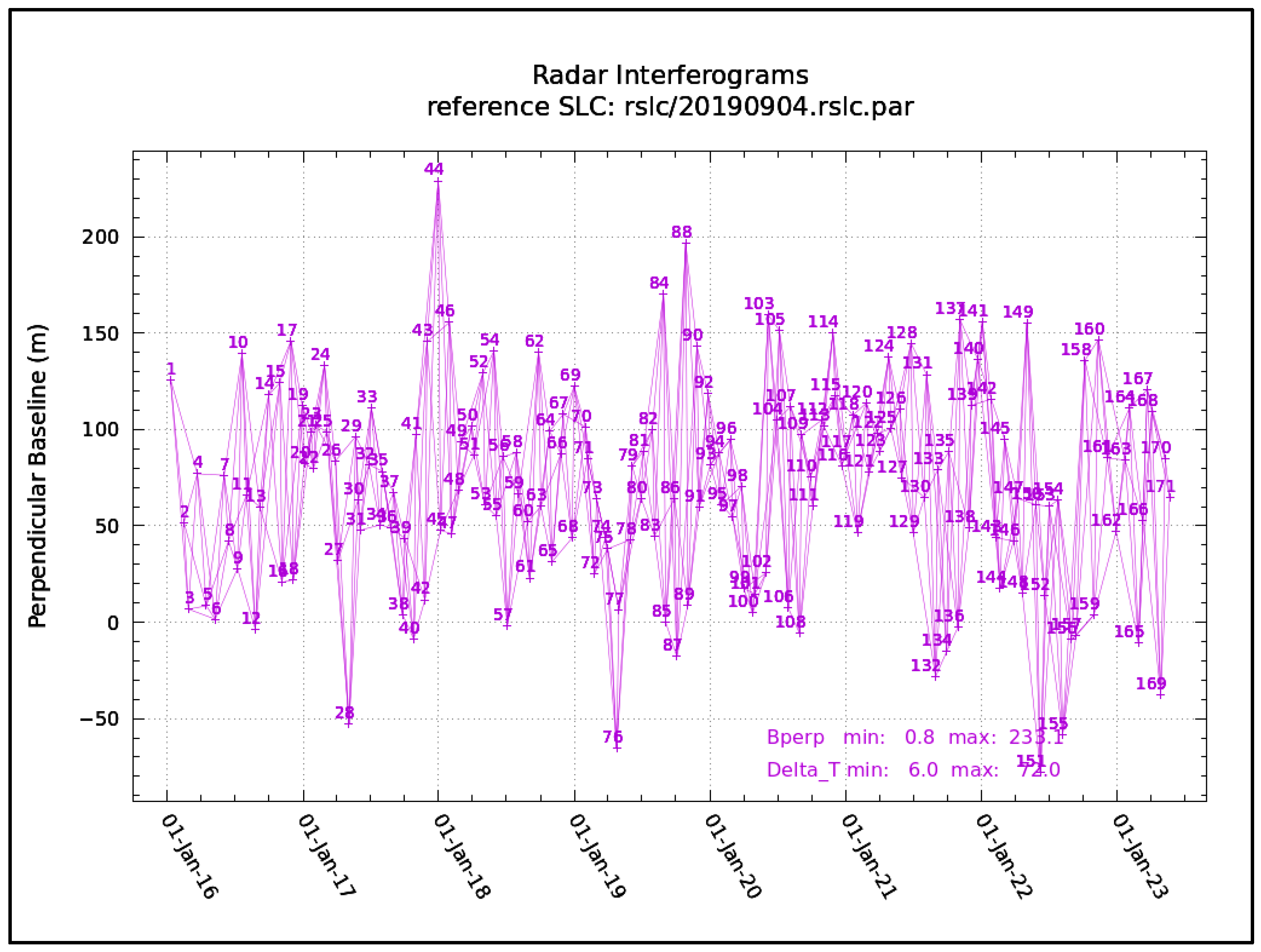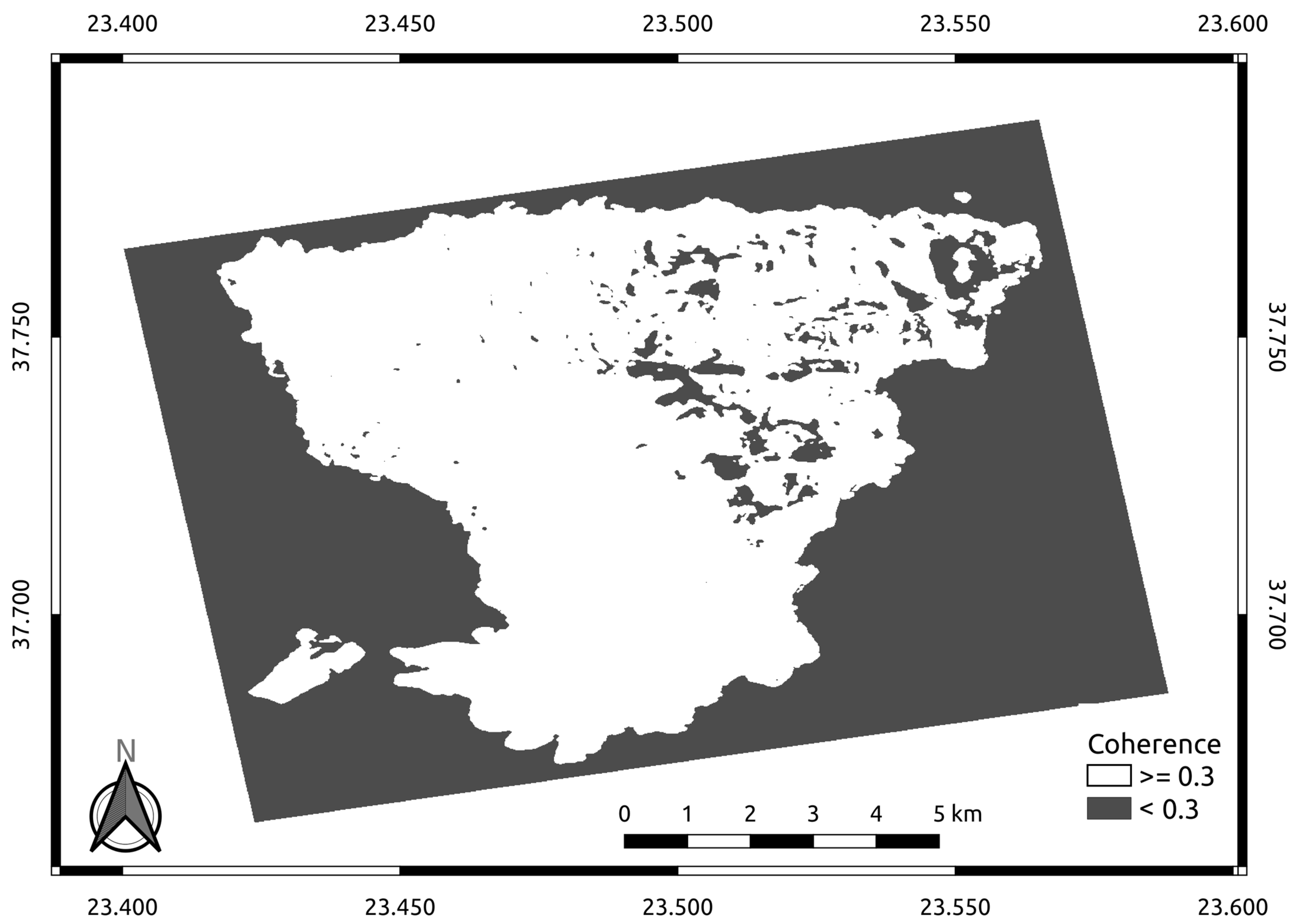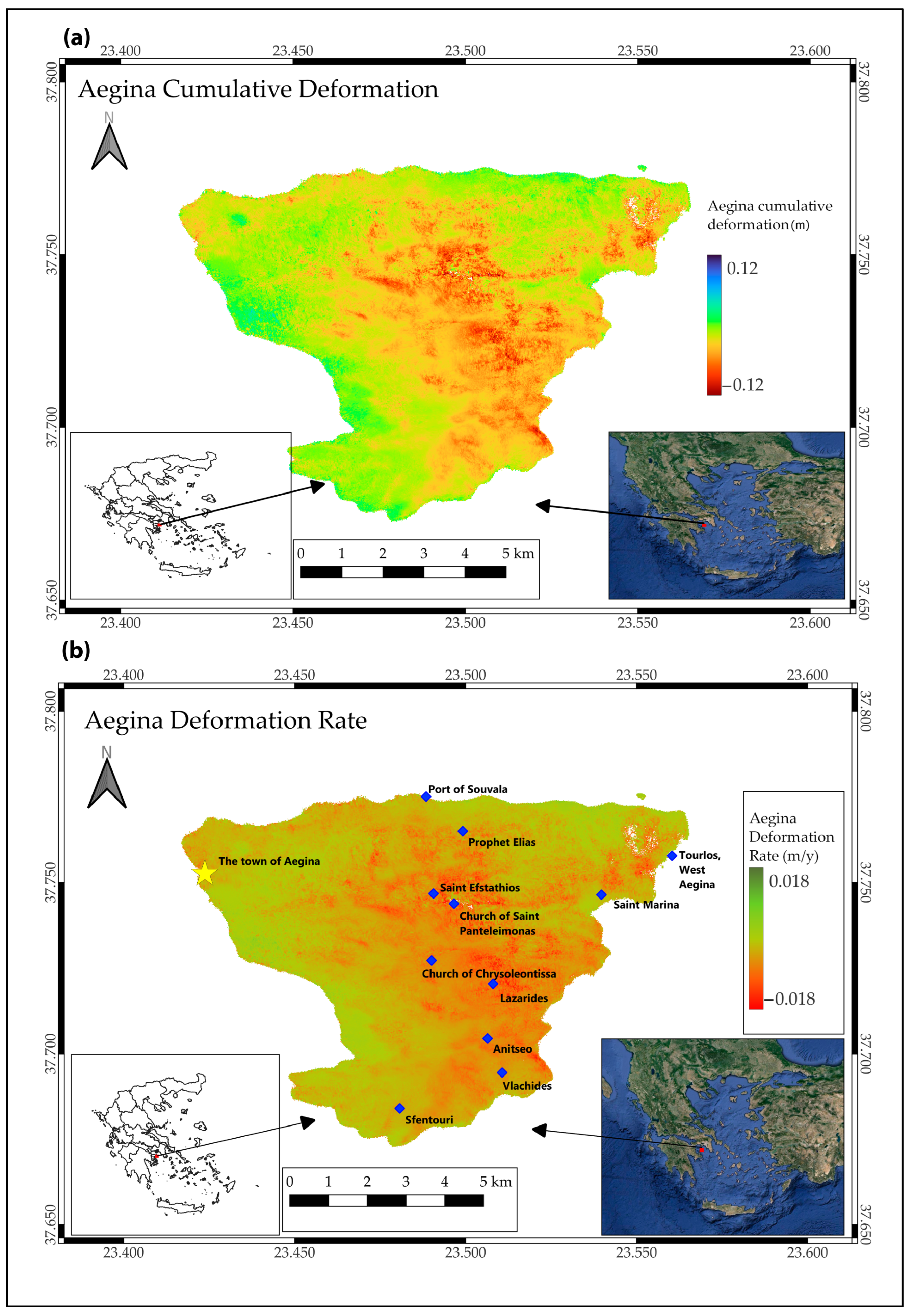Application of Time Series INSAR (SBAS) Method Using Sentinel-1 for Monitoring Ground Deformation of the Aegina Island (Western Edge of Hellenic Volcanic Arc)
Abstract
:1. Introduction

2. Materials and Methods
3. Results
4. Discussion
5. Conclusions
Author Contributions
Funding
Data Availability Statement
Acknowledgments
Conflicts of Interest
References
- Fytikas, M.; Innocenti, F.; Kolios, N.; Manetti, P.; Mazzuoli, R. The Plio-Quaternary volcanism of Saronikos area (western part of the active Aegean volcanic arc). Ann. Geol. Pays Hell. 1987, 33, 3–45. [Google Scholar]
- Francalanci, L.; Vougioukalakis, G.E.; Perini, G.; Manetti, P.A. West-East Traverse along the magmatism of the south Aegean volcanic arc in the lights of volcanological, chemical and isotope data. Dev. Volcanol. 2005, 7, 65–111. [Google Scholar] [CrossRef]
- Vougioukalakis, G.E.; Satow, C.G.; Druitt, T.H. Volcanism of the South Aegean Volcanic Arc. Elements 2019, 15, 159–164. [Google Scholar] [CrossRef]
- Drakatos, G.; Karastathis, V.; Makris, J.; Papoulia, J.; Stavrakakis, G. 3D crustal structure in the neotectonic basin of the Gulf of Saronikos (Greece). Tectonophysics 2005, 400, 55–65. [Google Scholar] [CrossRef]
- Papazachos, B.C.; Karakostas, V.G.; Papazachos, C.B.; Scordilis, E.M. The geometry of the Wadati-Benioff zone and lithospheric kinematics in the Hellenic arc. Tectonophysics 2000, 319, 275–300. [Google Scholar] [CrossRef]
- Makris, J.; Papoulia, J.; Drakatos, G. Tectonic deformation and microseismicity of the Saronikos Gulf, Greece. Bull. Seismol. Soc. Am. 2004, 94, 920–929. [Google Scholar] [CrossRef]
- Ganas, A.; Oikonomou, I.A.; Tsimi, C. NOAfaults: A digital database for active faults in Greece. Bull. Geol. Soc. Greece 2013, 47, 518–530. [Google Scholar] [CrossRef]
- Dietrich, V.J.; Gaitanakis, P.; Mercolli, J.; Oberhaensli, R. Geological map of Greece, Aegina island, 1:25,000. Bull. Geol. Soc. Greece 1993, 28, 555–566. [Google Scholar]
- Muller, P.; Kreutzer, H.; Harre, W. Radiometric dating of two extrusives from a Lower Pliocene marine section on Aegina Island, Greece. Newslett. Stratigr. 1979, 8, 70–78. [Google Scholar] [CrossRef]
- Pe-Pipper, G.; Piper, D.J.W.; Reynolds, P.H. Paleomagnetic stratigraphy and radiometric dating of the Pliocene volcanic rocks of Aegina, Greece. Bull. Volcanol. 1983, 46, 1–7. [Google Scholar] [CrossRef]
- Morris, A. Magnetic fabric and palaeomagnetic analyses of the Plio-Quaternary calc-alkaline series of Aegina Island, South Aegean volcanic arc, Greece. Earth Planet. Sci. Lett. 2000, 176, 91–105. [Google Scholar] [CrossRef]
- Keller, J. The major volcanic events in recent eastern Mediterranean volcanism and their bearing on the probem og Santorini ash layers. In Proceedings of the Acta 1st International Scientific Congress on the Volcano of Thera, Athens, Greece, 15–23 September 1969; Kaloyeropoyloy, A., Ed.; Arch Serv Greece: Athens, Greece, 1969; pp. 152–169. [Google Scholar]
- Francalanci, L.; Vougioukalakis, G.E.; Fytikas, M. Petrology and volcanology of Kimolos and Polyegos volcanoes within the context of the South Aegean arc, Greece. In Cenozoic Volcanism in the Mediterranean Area; Beccaluva, L., Bianchini, G., Wilson, M., Eds.; Special Paper Geological Society of America: Boulder, CO, USA, 2007; Volume 418, pp. 33–65. [Google Scholar] [CrossRef]
- Elburg, M.A.; Smet, I. Geochemistry of lavas from Aegina and Poros (Aegean Arc, Greece): Distinguishing upper crustal contamination and source contamination in the Saronic Gulf area. Lithos 2020, 358–359, 105416. [Google Scholar] [CrossRef]
- Vougioukalakis, G.E.; Fytikas, M. Volcanic hazards in the Aegean area, relative risk evaluation, monitoring and present state of the active volcanic centers. Dev. Volcanol. 2005, 7, 161–183. [Google Scholar] [CrossRef]
- Seismological Network of the Institute of Geodynamics. Available online: https://www.gein.noa.gr/en/networks-equipment/seismological-network-of-institute-of-geodynamics/ (accessed on 14 December 2023).
- Foumelis, M.; Trasatti, E.; Papageorgiou, E.; Stramondo, S.; Parcharidis, I. Monitoring Santorini volcano (Greece) breathing from space. Geophys. J. Int. 2013, 193, 161–170. [Google Scholar] [CrossRef]
- Lagios, E.; Sakkas, V.; Novali, F.; Bellotti, F.; Ferretti, A.; Vlachou, K.; Dietrich, V. SqueeSARTM and GPS ground deformation monitoring of Santorini Volcano (1992–2012): Tectonic implications. Tectonophysics 2013, 594, 38–59. [Google Scholar] [CrossRef]
- Papageorgiou, E.; Foumelis, M.; Parcharidis, I. Long- and short-term deformation monitoring of Santorini Volcano> Unrest evidence by DInSAR analysis. IEEE J. Sel. Top. Appl. Earth Obs. Remote Sens. 2012, 5, 1531–1537. [Google Scholar] [CrossRef]
- Papageorgiou, E.; Foumelis, M.; Trasatti, E.; Ventura, G.; Raucoules, D.; Mouratidis, A. Multi-sensor SAR geodetic imaging and modelling of Santorini volcano post-unrest response. Remote Sens. 2019, 11, 259. [Google Scholar] [CrossRef]
- Papoutsis, I.; Papanikolau, X.; Floyd, M.; Ji, K.H.; Kontoes, C.; Paradissis, D.; Zacharis, V. Mapping inflaction at Santorini volcano, Greece, using GPS and InSAR. Geophys. Res. Lett. 2013, 40, 267–272. [Google Scholar] [CrossRef]
- Parks, M.M.; Biggs, J.; England, P.; Mather, T.A.; Nomikou, P.; Palamartchouk, K.; Papanikolau, X.; Paradissis, D.; Parson, B.; Pyle, D.M.; et al. Evolution of Santorini Volcano dominated by episodic and rapid fluxes of melt from depth. Nat. Geosci. 2012, 5, 749–754. [Google Scholar] [CrossRef]
- Gatsios, T.; Cigna, F.; Tapete, D.; Sakkas, V.; Pavlou, K.; Parcharidis, I. Copernicus Sentinel-1 MT-InSAR, GNSS and Seismic Monitoring of Deformation Patterns and Trends at the Methana Volcano, Greece. Appl. Sci. 2020, 10, 6445. [Google Scholar] [CrossRef]
- Parcharidis, I.; Lagios, E. Deformation in Nisyros volcano (Greece) using differential radar interferometry. Bull. Geol. Soc. Greece 2001, 34, 1587. [Google Scholar] [CrossRef]
- Lagios, E.; Sakkas, V.; Parcharidis, I.; Dietrich, V. Ground deformation of Nisyros Volcano (Greece) for the period 1995-2002. Results from DInSAR and DGPS observations. Bull. Volcanol. 2005, 68, 201–214. [Google Scholar] [CrossRef]
- Lekkas, E.; Meletlidis, S.; Kyriakopoulos, K.; Manousaki, M.; Mavroulis, S.; Kostaki, E.; Michailidis, A.; Gogou, M.; Mavrouli, M.; Castro-Melgar, I.; et al. The 2021 Cumbre Vieja volcano eruption in La Palma (Canary Islands). Newsl. Environ. Disaster Cris. Manag. Strateg. 2021, 26. [Google Scholar] [CrossRef]
- Ebmeier, S.K.; Andrews, B.J.; Araya, M.C.; Arnold, D.W.D.; Biggs, J.; Cooper, C.; Cottrell, E.; Furtney, M.; Hickey, J.; Jay, J.; et al. Synthesis of global satellite observations of magmatic and volcanic deformation: Implications for volcano monitoring & the lateral extent of magmatic domains. J. Appl. Volcanol. 2018, 7, 2. [Google Scholar] [CrossRef]
- Dzurisin, D. A comprehensive approach to monitoring volcano deformation as a window on the eruption cycle. Rev. Geophys. 2003, 41, 1001. [Google Scholar] [CrossRef]
- Wicks, C.W.; Thatcher, W.; Dzurisin, D.; Svarc, J. Uplift, thermal unrest and magma intrusion at Yellowstone caldera. Nature 2006, 440, 72–75. [Google Scholar] [CrossRef] [PubMed]
- Ghaderpour, E.; Mazzanti, P.; Bozzano, F.; Mugnozza, G.S. Ground deformation monitoring via PS-InSAR time series: An industrial zone in Sacco River Valley, central Italy. Remote Sens. Appl. Soc. Environ. 2024, 34, 101191. [Google Scholar] [CrossRef]
- Orellana, F.; Moreno, M.; Yáñez, G. High-Resolution Deformation Monitoring from DInSAR: Implications for Geohazards and Ground Stability in the Metropolitan Area of Santiago, Chile. Remote Sens. 2022, 14, 6115. [Google Scholar] [CrossRef]
- Berardino, P.; Fornaro, G.; Lanari, R.; Sansoti, E. A new algorithm, for surface deformation monitoring based on small baseline differential SAR Interferograms. IEEE Trans. Geosci. Remote Sens. 2002, 40, 2375–2383. [Google Scholar] [CrossRef]
- Manunta, M.; De Luca, C.; Zinno, I.; Casu, F.; Manzo, M.; Bonano, M.; Fusco, A.; Pepe, A.; Onorato, G.; Berardino, P.; et al. The parallel SBAS approach for Sentinel-1 interferometric wide swath deformation time-series generation: Algorithm description and products quality assessment. IEEE Trans. Geosci. Remote Sens. 2019, 57, 6259–6281. [Google Scholar] [CrossRef]
- Di Traglia, F.; De Luca, C.; Manzo, M.; Nolesini, T.; Casagli, N.; Lanari, R.; Casu, F. Joint exploitation of space-borne and ground-based multitemporal InSAR measurements for volcano monitoring: The Stromboli volcano case study. Remote Sens. Environ. 2021, 260, 112441. [Google Scholar] [CrossRef]
- Ferretti, A. Satellite InSAR Data—Reservoir Monitoring from Space, 1st ed.; EAGE: Bunnik, The Netherlands, 2014; pp. 9–100. [Google Scholar]
- Singh Virk, A.; Singh, A.; Mittal, S.K. Advanced MT-InSAR Landslide Monitoring: Methods and Trends. J. Remote Sens. GIS 2018, 7, 1–6. [Google Scholar] [CrossRef]
- Yazbeck, J.; Rundle, J.B. A Fusion of Geothermal and InSAR Data with Machine Learning for Enhanced Deformation Forecasting at the Geysers. Land 2023, 12, 1977. [Google Scholar] [CrossRef]
- Guo, H.; Yuan, Y.; Wang, J.; Cui, J.; Zhang, D.; Zhang, R.; Cao, Q.; Li, J.; Dai, W.; Bao, H.; et al. Large-Scale Land Subsidence Monitoring and Prediction Based on SBAS-InSAR Technology with Time-Series Sentinel-1A Satellite Data. Remote Sens. 2023, 15, 2843. [Google Scholar] [CrossRef]
- Li, J.; Yan, Y.; Cai, J. LOS Deformation Correction Method for DInSAR in Mining Areas by Fusing Ground Data without Control Points. Remote Sens. 2023, 15, 4862. [Google Scholar] [CrossRef]
- Poland, M.P.; Zebker, H.A. Volcano geodesy using InSAR in 2020; the past and next decades. Bull. Volcanol. 2022, 84, 27. [Google Scholar] [CrossRef]
- Ezquerro, P.; Bru, G.; Galindo, I.; Montserrat, O.; García-Davalillo, J.C.; Sánchez, N.; Montoya, I.; Palamá, R.; Mateos, R.M.; Pérez-López, R.; et al. Analysis of SAR-derived products to support emergency management during volcanic crisis: La Palma case study. Remote Sens. Environ. 2023, 295, 113668. [Google Scholar] [CrossRef]
- Sakkas, V. Ground deformation modelling of the 2020 MW 6.9 Samos earthquake (Greece) based on InSAR and GNSS data. Remote Sens. 2021, 13, 1665. [Google Scholar] [CrossRef]
- Beccaro, L.; Tolomei, C.; Gianardi, R.; Sepe, V.; Bisson, M.; Colini, L.; De Ritis, R.; Spinetti, C. Multitemporal and multisensory InSAR analysis for ground displacement field assessment at Ischia volcanic island (Italy). Remote Sens. 2021, 13, 4253. [Google Scholar] [CrossRef]
- Parks, M.; Sigmundsson, F.; Sigurdsson, O.; Hooper, A.; Hreinsdóttir, S.; Ófeigsson, B.; Michalczewska, K. Deformation due to geothermal explotation at Reykjanes, Iceland. J. Volcanol. Geotherm. Res. 2020, 391, 1064338. [Google Scholar] [CrossRef]
- Doke, R.; Kikugawa, G.; Itadera, K. Very local subsidence near the hot spring region in Hakone Volcano, Japan, inferred from InSAR time series analysis of ALOS/PALSAR data. Remote Sens. 2020, 12, 2842. [Google Scholar] [CrossRef]
- Li, M.; Ge, D.; Guo, X.; Zhang, L.; Liu, B.; Wang, Y.; Wu, Q.; Wan, X.; Wang, Y. Mapping and Analyses of Land Subsidence in Hengshui, China, Based on InSAR Observations. Land 2023, 12, 1684. [Google Scholar] [CrossRef]
- Rehman, M.U.; Zhang, Y.; Meng, X.; Su, X.; Catani, F.; Rehman, G.; Yue, D.; Khalid, Z.; Ahmad, S.; Ahmad, I. Analysis of Landslide Movements Using Interferometric Synthetic Aperture Radar: A Case Study in Hunza-Nagar Valley, Pakistan. Remote Sens. 2020, 12, 2054. [Google Scholar] [CrossRef]
- Salepci, N.; Thiel, C. Radar Remote Sensing—Introduction into SAR measurements, Data characteristics & challenges. In Proceedings of the ESA PECS SAR Remote Sensing Course, Bratislava, Slovakia, 17–21 September 2018; Friedrich Schiller University: Jena, Germany, 2018. [Google Scholar]
- Lanari, R.; Mora, O.; Manunta, M.; Mallorqui, J.J.; Berardino, P.; Sansosti, E. A small-baseline approach for investigations deformations on full-resolution differential SAR interferograms. IEEE Trans. Geosci. Remote Sens. 2004, 42, 1377–1386. [Google Scholar] [CrossRef]
- Nikaein, T.; Ianninni, L.; Molijn, R.A.; Lopez-Dekker, P. On the value of Sentinel-1 InSAR coherence time-series for vegetation classification. Remote Sens. 2021, 13, 3300. [Google Scholar] [CrossRef]
- Médail, F. Plant biogeography and vegetation patterns of the Mediterranean Islands. Bot. Rev. 2022, 88, 63–129. [Google Scholar] [CrossRef]
- Gkougkoustamos, I.; Krassakis, P.; Kalogeropoulou, G.; Parcharidis, I. Correlation of Ground Deformation Induced by the 6 February 2023 M7.8 and M7.5 Earthquakes in Turkey Inferred by Sentinel-2 and Critical Exposure in Gaziantep and Kahramanmaraş Cities. GeoHazards 2023, 4, 267–285. [Google Scholar] [CrossRef]
- Ka, M.-H.; Shimkin, P.E.; Baskakov, A.I.; Babokin, M.I. A New Single-Pass SAR Interferometry Technique with a Single-Antenna for Terrain Height Measurements. Remote Sens. 2019, 11, 1070. [Google Scholar] [CrossRef]
- Younis, M. Synthetic Aperture Radar (SAR): Principles and Applications. University of Agriculture and Veterinary Medicine. In Proceedings of the 6th ESA Advanced Training Course on Land Remote Sensing, Bucharest, Romania, 14–18 September 2015. [Google Scholar]
- Karavias, A. Monitoring Impacts of Climate Change on Surface Subsidence Using SAR Interferometry after the Activation of Karla Lake Reservoir for Water-Consuming Control for Irrigation. Master’s Thesis, Harokopio University, Athens, Greece, 2021. [Google Scholar]
- Hu, J.; Ge, Q.; Liu, J.; Yang, W.; Du, Z.; He, L. Theory and Application of Monitoring 3-D Deformation with InSAR; Science Press: Beijing, China, 2021. [Google Scholar]
- Liu, G.; Chen, Q.; Chen, X.; Cai, G. InSAR Principles and Applications; Science Press: Beijing, China, 2019. [Google Scholar]
- Centre Sismologique Euro-Méditerranéen, Euro-Mediterranean Seismological Centre. Search Earthquakes in the Period 1 January 2016 to 31 May 2023. Available online: https://www.emsc-csem.org/Earthquake_information/ (accessed on 20 March 2024).
- Matsuda, J.; Senoh, K.; Maruoka, T.; Sato, H.; Mitropoulos, P. K-Ar ages of the Aegean volcanic rocks and their implications for the arc-trench system. Geochem. J. 1999, 33, 369–377. [Google Scholar] [CrossRef]








| Station | VE (mm/year) | VN (mm/year) | VU (mm/year) |
|---|---|---|---|
| AIGI | 9.04 ± 0.08 | −11.70 ± 0.16 | 2.98 ± 0.32 |
Disclaimer/Publisher’s Note: The statements, opinions and data contained in all publications are solely those of the individual author(s) and contributor(s) and not of MDPI and/or the editor(s). MDPI and/or the editor(s) disclaim responsibility for any injury to people or property resulting from any ideas, methods, instructions or products referred to in the content. |
© 2024 by the authors. Licensee MDPI, Basel, Switzerland. This article is an open access article distributed under the terms and conditions of the Creative Commons Attribution (CC BY) license (https://creativecommons.org/licenses/by/4.0/).
Share and Cite
Kalavrezou, I.-E.; Castro-Melgar, I.; Nika, D.; Gatsios, T.; Lalechos, S.; Parcharidis, I. Application of Time Series INSAR (SBAS) Method Using Sentinel-1 for Monitoring Ground Deformation of the Aegina Island (Western Edge of Hellenic Volcanic Arc). Land 2024, 13, 485. https://doi.org/10.3390/land13040485
Kalavrezou I-E, Castro-Melgar I, Nika D, Gatsios T, Lalechos S, Parcharidis I. Application of Time Series INSAR (SBAS) Method Using Sentinel-1 for Monitoring Ground Deformation of the Aegina Island (Western Edge of Hellenic Volcanic Arc). Land. 2024; 13(4):485. https://doi.org/10.3390/land13040485
Chicago/Turabian StyleKalavrezou, Ioanna-Efstathia, Ignacio Castro-Melgar, Dimitra Nika, Theodoros Gatsios, Spyros Lalechos, and Issaak Parcharidis. 2024. "Application of Time Series INSAR (SBAS) Method Using Sentinel-1 for Monitoring Ground Deformation of the Aegina Island (Western Edge of Hellenic Volcanic Arc)" Land 13, no. 4: 485. https://doi.org/10.3390/land13040485
APA StyleKalavrezou, I.-E., Castro-Melgar, I., Nika, D., Gatsios, T., Lalechos, S., & Parcharidis, I. (2024). Application of Time Series INSAR (SBAS) Method Using Sentinel-1 for Monitoring Ground Deformation of the Aegina Island (Western Edge of Hellenic Volcanic Arc). Land, 13(4), 485. https://doi.org/10.3390/land13040485








